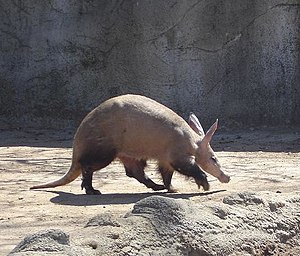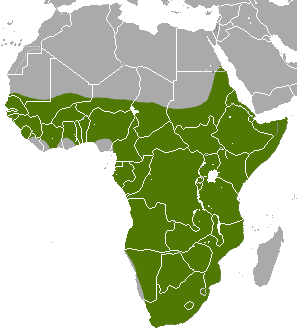Aardvark: Difference between revisions
imported>Howard C. Berkowitz No edit summary |
mNo edit summary |
||
| (15 intermediate revisions by 3 users not shown) | |||
| Line 1: | Line 1: | ||
{{subpages}} | {{subpages}} | ||
The '''aardvark''' ( | __NOTOC__ | ||
{{Image|Porc formiguer.JPG|right|300px|An aardvark at the [[Detroit, Michigan|Detroit]] zoo in 2008.}} | |||
{{Image|Aardvark area.png|right|300px|Range map for the aardvark in [[Africa]].}} | |||
The '''aardvark''' (''Orycteropus afer'') is a medium-sized, burrowing, night-roaming [[mammal]] found in central and southern Africa. It is a timid and defenseless animal about the size of a small pig, with a long head, a pig-like snout, and long donkey-like ears. Aardvarks mainly eat ants and termites, which they will dig out of their hills using sharp claws and powerful legs. They also dig to create burrows in which to live and rear young. Aardvarks are such strong diggers that they can burrow themselves into a newly created hole in five minutes. They have been known to dig tunnels large enough for a small man to navigate.<ref>Oxford Paperback Encylopedia</ref> | |||
== Names and sub-species == | |||
The word ''aardvark'' is [[Afrikaans]] for "earth-pig". The animal is also colloquially sometimes called "African ant bear", "anteater" (''not'' the same as a South American anteater), or "Cape anteater"<ref name="Colliers">{{harvnb|Goodwin|1997|pp=2–3}}</ref>. The genus name ''Orycteropus'' means "burrowing foot", and the name ''afer'' refers to Africa. Seventeen subspecies of aardvarks have been identified, but differences among them are poorly defined. | |||
==Attribution== | |||
{{WPAttribution}} | |||
==References== | |||
<references />[[Category:Suggestion Bot Tag]] | |||
Latest revision as of 13:53, 5 July 2024


The aardvark (Orycteropus afer) is a medium-sized, burrowing, night-roaming mammal found in central and southern Africa. It is a timid and defenseless animal about the size of a small pig, with a long head, a pig-like snout, and long donkey-like ears. Aardvarks mainly eat ants and termites, which they will dig out of their hills using sharp claws and powerful legs. They also dig to create burrows in which to live and rear young. Aardvarks are such strong diggers that they can burrow themselves into a newly created hole in five minutes. They have been known to dig tunnels large enough for a small man to navigate.[1]
Names and sub-species
The word aardvark is Afrikaans for "earth-pig". The animal is also colloquially sometimes called "African ant bear", "anteater" (not the same as a South American anteater), or "Cape anteater"[2]. The genus name Orycteropus means "burrowing foot", and the name afer refers to Africa. Seventeen subspecies of aardvarks have been identified, but differences among them are poorly defined.
Attribution
- Some content on this page may previously have appeared on Wikipedia.
References
- ↑ Oxford Paperback Encylopedia
- ↑ Goodwin 1997, pp. 2–3